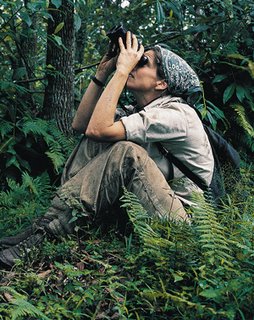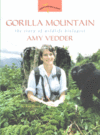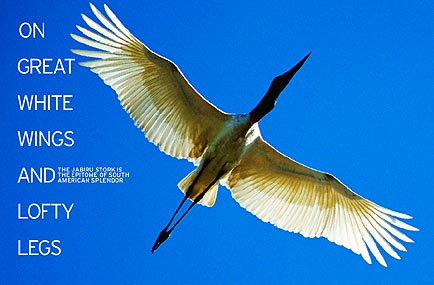Sunday, October 15, 2006
Rene Ebersole writes and edits articles and books relating to science, the environment, and health. In her journalistic pursuits she has waded in swamps inhabited by alligators, witnessed a 200-pound bear getting a root canal, and donned scuba gear to wrestle with octapuses. As staff Features Editor at Audubon magazine, she oversees articles on birds, wildlife, habitats, gardening, lifestyles, and travel. Her book, "Gorilla Mountain," a children's biography of gorilla biologist Amy Vedder was published by Joseph Henry Press and Scholastic. Rene has also worked recently as a a faculty member of NYU's graduate-level Science, Health, and Environmental Reporting Program, of which she is also an alumnus. This blog temporarily showcases some of her work, which will soon be moving to a more permanent website at reneebersole.com. Updates are coming soon.
Friday, June 30, 2006
The Original Oz
Audubon
July-August 2006

Scorching deserts filled with birdsong, a coast dotted with life-restoring aboriginal fires, rivers pulsing with crocodiles. At once the most dangerous and beautiful place on earth, Australia’s Northern Territory is the true outback that legendary explorers couldn’t conquer. Read the story
July-August 2006

Scorching deserts filled with birdsong, a coast dotted with life-restoring aboriginal fires, rivers pulsing with crocodiles. At once the most dangerous and beautiful place on earth, Australia’s Northern Territory is the true outback that legendary explorers couldn’t conquer. Read the story
Tuesday, May 16, 2006
Where the Eagles Are

National Wildlife
Dec/Jan 2005
With bald eagle numbers soaring, you can now see great gatherings of wintering eagles all across the Lower 48; we show you where to go. Read the Story
The New Zoo

Audubon Magazine
November 2001
Once upon a time, zoos existed solely for entertaining people. At today's best zoos, millions of visitors have fun learning about conservation while becoming inspired to give money to save wildlife in wild places. Read the article
iwaswondering.org

A fun and interactive Web site showcases the Women's Adventures in Science series and Gorilla Mountain. Take an adventure in science with Lia, the spunky site host, who says "I think scientists are like rock stars." Play games, check out the scientists' scrap books, and do real-life experiments. Visit the Site
Read the series review in Discover magazine
Gorilla Mountain: The Story Of Wildlife Biologist Amy Vedder (Women's Adventures in Science)

Amy Vedder leads a wild life. How many people can say they were once a member of a mountain gorilla family? Amy is a wildlife biologist, a scientist who studies animals and their behavior. She uses her knowledge to save animals whose lives and habitats are threatened. Amy once lived in a remote part of central Africa, where she helped rescue Rwanda’s mountain gorillas from extinction. She did groundbreaking science in a beautiful rain forest environment, but it wasn’t always easy. She had to face tough conditions in a country affected by conflict and war. In the process, she met unforgettable people—and unforgettable gorillas. Today Amy travels the world, from her home base at New York’s Bronx Zoo to the far reaches of Mongolia in Asia. Everywhere she goes, she teaches people how to appreciate and protect the precious wildlife that surrounds them. Gorilla Mountain is the thrilling story of a scientist and her science. To tell this true tale of adventure, author Rene Ebersole drew on firsthand accounts from Amy and her friends, family, and colleagues. How did a young nature lover become a powerful champion of great apes? The life story of Amy Vedder will intrigue and inspire readers of all ages. Buy the Book
Embedded Troops

National Wildlife
August/Sept 2005
THE DEATH MARCH begins in the pale light just before sunrise as the female assassins stream from their temporary bastion concealed deep in a tropical thicket. Raucous birds peer down from the canopy, anticipating the drama that is about to unfold.
All at once, the cutthroats start running, converging to form a powerful front that takes down nearly every living creature in its path. This force of nature has been known to native peoples as padicours, tuocas, tepeguas and soldados. In English, it is the army ants—“the Huns and Tartars of the insect world,” wrote entomologist W.M. Wheeler in the early 1900s. Read the Article
Monkeys from Heaven

National Wildlife
June/July 2003
THE LEGEND of the sacred monkey traces back more than 20 centuries to an old Hindu epic of Hanuman, the god of monkeys. In a battle of good versus evil, Hanuman leaps from the coast of India to rescue his king’s abducted queen from the island of Lankah (present-day Sri Lanka). Setting the island kingdom ablaze with his tail, Hanuman distracts the queen’s captors and sets her free. Today, the fabled deity is still worshipped for his brave deeds—his charred face and limbs a national symbol of strength. Many devout Hindus regard the black skin of Hanuman langurs as proof that they are the living descendants of the monkey god. But the mysterious intrigue surrounding these monkeys doesn’t stop with their royal legacy. For decades, scientists have marveled at their social behaviors—some of them jarringly violent—as well as Semnopithecus entellus’s dogged ability to survive in a diverse range of environments, from the brutally hot sands of the Great Indian Desert to the snow-capped Himalayan Mountains. Next to man, the Hanuman langur inhabits a wider array of landscapes than any other primate in the world. Read the Article
Black Bears on the Mend

National Wildlife
Aug/Sept 2005
TWO HUNDRED POUNDS of black fur and solid muscle sprawl on a gurney in a small room at the University of Tennessee College of Veterinary Medicine. The patient, a wild black bear captured at a popular picnic area in Great Smoky Mountains National Park, is being prepped for x-rays. National Park Service biologist Bill Stiver paces in the hallway, waiting for the doctor’s prognosis. An hour ticks by. Then veterinarian Ed Ramsey emerges from the x-ray room. “This bear had better learn karate—his teeth are in bad shape,” Ramsey says. “We’ll have to do some root canals.” Stiver is not surprised. He has approved dental surgery for bears before, an indication of the lengths to which authorities will go to keep the Great Smokies icon out of trouble. “Teeth are the weak link for bears,” Stiver says. “When the teeth go, they become nuisance bears, eating garbage and strolling through picnic areas. Once the problem is corrected, we tend not to see these animals anymore.” Read the Article
Out of Breath

National Wildlife
April/May 2005
If nothing is done to break the planet’s mounting fever, scientists offer a cloudy forecast for the millions of Americans who suffer from asthma. Read the Article
Delicate Affair

National Wildlife
Feb/March 2005
Wildlife biologist Larry Richardson will do almost anything to save South Florida’s rare orchids; he will even court a flower. Read the Article
Drink Responsibly, Choose Eco-Friendly Wines

National Wildlife
Nov/Dec 2004
THE TERIYAKI-GLAZED SALMON is Alaskan wild caught. The baby greens salad and accompanying herbed carrots are organic—and locally grown to boot. Free of chemicals, harvested sustainably and easy on energy reserves, it’s a meal that would make Mother Earth proud. But what kind of wine would you pick to complement this dinner? Would you go with an organic varietal? Or stick with something acclaimed more for its taste than its environmental aspect? Years ago, many wine aficionados wouldn’t even entertain the thought of serving "organic wine"; the mere words conjured up images of aging hippies fermenting vinegar in their basements. Today, however, earth-friendly offerings are popping up on wine menus in white-linen restaurants from New York to San Francisco. Read the Article
One Tough Tiger

National Wildlife
Dec/Jan 2004
ON A BITTER-COLD February morning, Howard Quigley stood along the rocky shore of the Sea of Japan peering down a rifle barrel at an angry tiger fighting to break free of the snare that had captured her. She lunged from the tall grasses some 30 feet away and snarled a menacing, guttural growl that made the hairs on the back of Quigley's neck stand on end. He focused the gun's cross-hairs on his target's shoulder, trying to ignore the cat's bone-chilling roars. Read the Article
Open-Shut Case

National Wildlife
Aug/Sept 2004
A curious scientist investigating how the world is perceived by other animals stumbles upon the alligator’s "sixth sense"
Read the Article
Is Your Drinking Water Safe?
 National Wildlife
National WildlifeJune/July 2004
IT'S CLEAR, SMELLS FRESH, TASTES GOOD. But is it safe to drink? Most of us have considered this question, whether sipping tap water while traveling or making lemonade at home. Truth is American water supplies are some of the cleanest in the world. Still, it sure doesn’t hurt to be cautious. Read the Article
Monday, May 15, 2006
Shell Struck in Florida

National Wildlife
April/May 2004
MATT ARESCO couldn’t help but notice the big, bloody turtle shells strewn up and down the northbound lane of U.S. Highway 27 along the edge of Lake Jackson in Tallahassee, Florida. Some were almost entirely intact. Others were shattered. Hitting the brakes, he eased off the highway, climbed out and started walking. Pausing to investigate each carcass, the 38-year-old herpetologist began stacking them on a large blue tarp. Before long, the pile stood 90 shells high and represented 10 different species.
Read the Article
On Great White Wings and Lofty Legs
 National Wildlife
National WildlifeApril/May 2004
STANDING TALL against the backdrop of the world’s largest wetland, the jabiru stork looks like a creature straight out of the Jurassic. Nearly five feet of feathers and beak, this imposing figure in a white suit and flashy red necktie dwarfs the other avian waders drawn to the Pantanal’s rich waters. Usually spotted alone or in pairs, jabirus are so abundant in this region, which extends through parts of Brazil, Bolivia and Paraguay, that it’s possible to see dozens of their ivory bodies spread out across the watery expanse. Read the Article
Saving the Sage Grouse

National Wildlife
Dec/Jan 2003
TAKE ONE LOOK at a male sage grouse performing his mating dance—his spiky tail feathers erected, yellow eye combs flashing and olive green air sacs ballooning from his chest—and you will know why Meriwether Lewis and William Clark dubbed it the "cock of the plains." But like so many other creatures chronicled in great numbers by Lewis and Clark, sage grouse populations have fallen to only a fraction of their historic records.
Read the Article
Live on a Leaf in Panama

National Wildlife
Aug/Sept 2003
In the middle of the world’s most famous shipping lane, more than 1,300 types of plants shape, feed and shelter an island paradise. Read the Article
Recycle Cell Phones, Reduce Toxic Waste

National Wildlife, June/July 2003
MOST OF US have bought one for some reason or another: It could save your life in an emergency; you need to keep in touch with family when you’re on the go; you like the freedom of being able to talk anytime, anywhere. But what do you do with that miraculous little bundle of plastic and fiber optics when you switch to another cell phone company, upgrade to a better plan or splurge on a fancy new phone with all the digital bells and whistles? If you’re like most people, you toss the old phone in a drawer or throw it in the trash. And that’s the rub. According to a recent report, 130 million cell phones—complete with batteries and chargers—will be pitched each year by 2005, adding up to an annual glut of 65,000 tons of garbage. Dumped in landfills and burned in incinerators, all that wireless waste is causing serious environmental problems and threatening human health, say experts.
Read the article
Wallace Stegner: His Writing Helped Keep Wilderness Wild

National Wildlife Magazine, Feb/March 2003
WALLACE STEGNER was never one to curl up on the couch with an old Western movie. He was usually far too busy for that sort of thing. Not to mention the fact that he hated Hollywood's vision of the "wild" West: rugged cowboys riding off into sunsets, Indians toting tomahawks. The silver-haired author was much more likely to be found in his study, peering through black, plastic-rimmed glasses as he tapped away at a novel about the real wild West: "A more fragile environment than any well-watered country," he once said, and when hurt, it "doesn't heal."
Read the article
